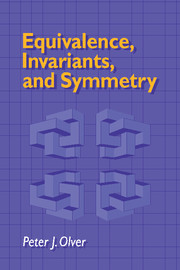Book contents
- Frontmatter
- Contents
- Preface
- Acknowledgments
- Introduction
- 1 Geometric Foundations
- 2 Lie Groups
- 3 Representation Theory
- 4 Jets and Contact Transformations
- 5 Differential Invariants
- 6 Symmetries of Differential Equations
- 7 Symmetries of Variational Problems
- 8 Equivalence of Coframes
- 9 Formulation of Equivalence Problems
- 10 Cartan's Equivalence Method
- 11 Involution
- 12 Prolongation of Equivalence Problems
- 13 Differential Systems
- 14 Frobenius' Theorem
- 15 The Cartan–Kähler Existence Theorem
- Tables
- References
- Symbol Index
- Author Index
- Subject Index
9 - Formulation of Equivalence Problems
Published online by Cambridge University Press: 05 August 2012
- Frontmatter
- Contents
- Preface
- Acknowledgments
- Introduction
- 1 Geometric Foundations
- 2 Lie Groups
- 3 Representation Theory
- 4 Jets and Contact Transformations
- 5 Differential Invariants
- 6 Symmetries of Differential Equations
- 7 Symmetries of Variational Problems
- 8 Equivalence of Coframes
- 9 Formulation of Equivalence Problems
- 10 Cartan's Equivalence Method
- 11 Involution
- 12 Prolongation of Equivalence Problems
- 13 Differential Systems
- 14 Frobenius' Theorem
- 15 The Cartan–Kähler Existence Theorem
- Tables
- References
- Symbol Index
- Author Index
- Subject Index
Summary
We now consider more general problems of equivalence, in which the equivalence conditions can be rewritten using differential forms, but a fully invariant coframe is not so immediately apparent. Nevertheless, in most cases, an invariant coframe which completely characterizes the equivalence problem does exist, and so the problem can actually be handled by the methods in the previous chapter. The difficulty is that the formulae for the invariant coframe are not obvious, and may require considerable ingenuity to construct ab initio. Fortunately, for those of us unendowed with the requisite insight, Cartan devised a general procedure that, starting with an equivalence problem suitably encoded using differential forms, eventually produces the explicit formulas for the desired invariant coframe. Thus, even though we are not able (or not clever enough) to immediately write down the invariant coframe, just being able to rewrite the problem in terms of differential forms allows us to apply the powerful algorithm developed by Cartan, and thereby deduce the solution to the original equivalence problem. As with our earlier analysis of the equivalence problem for coframes, Cartan's method reduces to an inspired exploitation of the invariance of the exterior derivative.
Equivalence Problems Using Differential Forms
In Cartan's approach, the conditions of equivalence of two objects (differential equations, polynomials, variational problems, differential operators, etc.) must be reformulated in terms of differential forms or, even more specifically, differential one-forms. We associate a collection of one-forms to an object under investigation in the original coordinates; the corresponding object in the new coordinates will have its own collection of one-forms.
Information
- Type
- Chapter
- Information
- Equivalence, Invariants and Symmetry , pp. 280 - 303Publisher: Cambridge University PressPrint publication year: 1995
